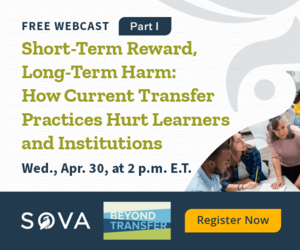Short-Term Reward, Long-Term Harm: How Current Transfer Practices Hurt Learners and Institutions
Learn how to build better incentives and structures that support transfer and remove barriers for today’s learners.

Most colleges and universities aim to put students first, but many have baked-in financial disincentives that work against transfer and credit mobility. In a recent national poll of adult Americans by Public Agenda and Sova, 4 in 10 respondents report attempting to transfer credit. Of these, 16% abandoned their postsecondary plans because the process of transferring credit was too difficult.
While restrictive and rejective credit transfer policies may produce short-term financial returns for institutions, they hurt learners at scale and harm institutional bottom lines and reputations in the long run.
Join the first of a two-part webcast series on shifting away from a mindset against credit mobility toward one that supports credit applicability—and success for all learners.
Register for part two of this two-part webcast series, on Wednesday, May 28, at 2 p.m. E.T. See how adopting a credit applicability mindset—versus the more traditional, credit-rejective approach—makes sense not only from a student success perspective but also a financial one.


